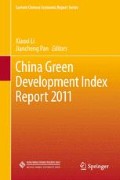Abstract
The secondary industry has already scored notable achievements since the reform and opening-up in China. However, surging energy prices and worsening environmental quality has brought new challenges to the green growth of the secondary industry. This chapter, based on the features of the secondary industry’s green growth and its existing problems during the 11th Five-Year Plan period, respectively analyzes the differences among provinces and cities, makes predictions on the secondary industry’s green growth during the 12th Five-Year Plan period and probes into its development opportunities and challenges.
Access this chapter
Tax calculation will be finalised at checkout
Purchases are for personal use only
Notes
- 1.
Chinese Statistics Web Links: Industrial Economy has played a splendid role in maintaining growth and adjusting structure, http://www.stats.gov.cn/tjfx/ztfx/sywcj/t20110304_402707882.htm,2011-03-04.
- 2.
Beijing Economic Information Net: China has made great progress on economic restructuring during the 11th Five-Year Plan period, http://www.beinet.net.cn/fxyj/yjbg/201103/t769725.htm,2011-03-11.
- 3.
The Task Group of the State Development Research Center. 12 development issues during the 12th Five-Year Plan period, Beijing: China Development Press, 2010.
- 4.
Mechanical Equipment Net: Industrial Economy’s Performance in the First Quarter of 2011, http://www.jx108.cn/news/zixun/jyzdao/20110423111704.html,2011-04-23.
- 5.
Beijing Economic Information Net: China has made great progress on economic restructuring during the 11th Five-Year Plan period, http://www.beinet.net.cn/fxyj/yjbg/201103/t769725.htm,2011-03-11.
- 6.
Beijing Economic Information Net: China has made great progress on economic restructuring during the 11th Five-Year Plan period, http://www.beinet.net.cn/fxyj/yjbg/201103/t769725.htm,2011-03-11.
- 7.
Tsinghua University Construction Energy Conservation Research Center. The Annual Research Report of Development of Construction Energy Conservation of 2008. Beijing: China Architecture & Building Press, 2008.
- 8.
International Iron and Steel Institute. 2011 will witness an increase in global steel consumption, http://futures.stockstar.com/IG.
- 9.
Global Cement Consumption Decreased by 1.7 % in 2009, http://www.ccement.com/news/Content/29652.html,2009-07-13.
- 10.
Reorganize according to the report of MOHURD (Ministry of Housing and Urban–Rural Development of People’s Republic of China) on the results of special supervision on energy conservation and emission reduction in the field of national housing and urban–rural development [Division of Establishment and Operation, (2011) 25], http://www.mohurd.gov.cn/zcfg/jswj/jskj/201104/t20110421_203196.htm,2011-04-21.
- 11.
Eastern region includes 10 provinces namely Beijing, Tianjin, Hebei, Shanghai, Jiangsu, Zhejiang, Fujian, Shandong, Guangdong and Hainan; central region includes 6 provinces namely Shanxi, Anhui, Jiangxi, Henan, Hubei and Hunan; western region includes Inner Mongolia, Guangxi, Chongqing, Sichuan, Guizhou, Yunnan, Tibet, Shaaxi, Gansu, Qinghai, Ningxia and Xinjiang namely 12 provinces; northeastern region refers to Liaoning, Jilin and Heilongjiang, those three provinces. Due to the lack of data in Tibet, Tibet is not included when calculation is conducted. Therefore, the provinces included in comparison add up to 30.
- 12.
Municipalities refer to Beijing, Tianjin, Shanghai and Chongqing.
- 13.
Separate planning cities refer to Shenzhen, Qingdao, Dalian, Ningbo and Xiamen.
- 14.
Provincial capitals include Shijiazhuang, Taiyuan, Hohhot, Shenyang, Changchun, Harbin, Nanjing, Hangzhou, Hefei, Fuzhou, Nanchang, Jinan, Zhengzhou, Wuhan, Changsha, Guangzhou, Nanning, Haikou, Chengdu, Guiyang, Kunming, Xi’an, Yinchuan, Lanzhou and Xining.
Author information
Authors and Affiliations
Editor information
Editors and Affiliations
Rights and permissions
Copyright information
© 2012 Springer-Verlag Berlin Heidelberg
About this chapter
Cite this chapter
Zhang, J., Ma, H., Wang, X. (2012). Green Growth of the Secondary Industry. In: Li, X., Pan, J. (eds) China Green Development Index Report 2011. Current Chinese Economic Report Series. Springer, Berlin, Heidelberg. https://doi.org/10.1007/978-3-642-31597-8_4
Download citation
DOI: https://doi.org/10.1007/978-3-642-31597-8_4
Published:
Publisher Name: Springer, Berlin, Heidelberg
Print ISBN: 978-3-642-31596-1
Online ISBN: 978-3-642-31597-8
eBook Packages: Business and EconomicsEconomics and Finance (R0)

